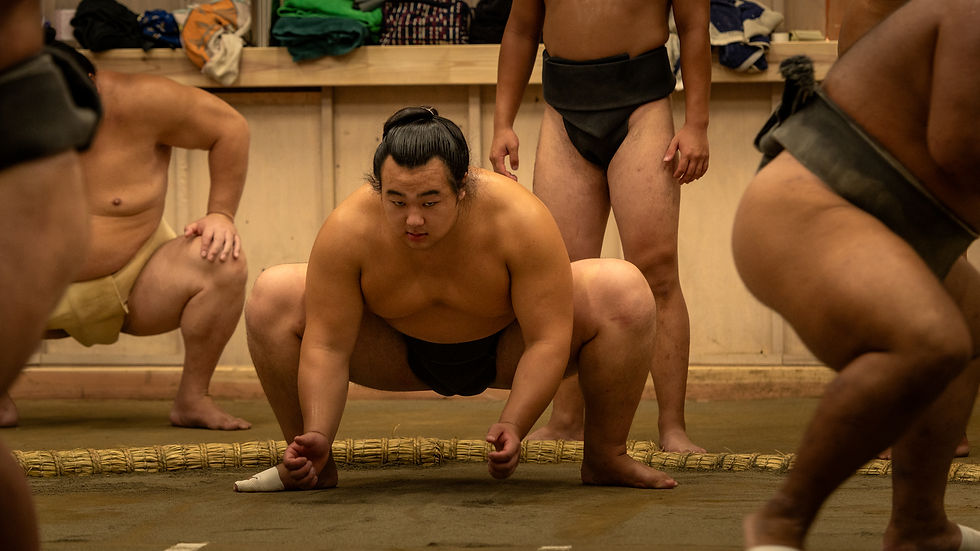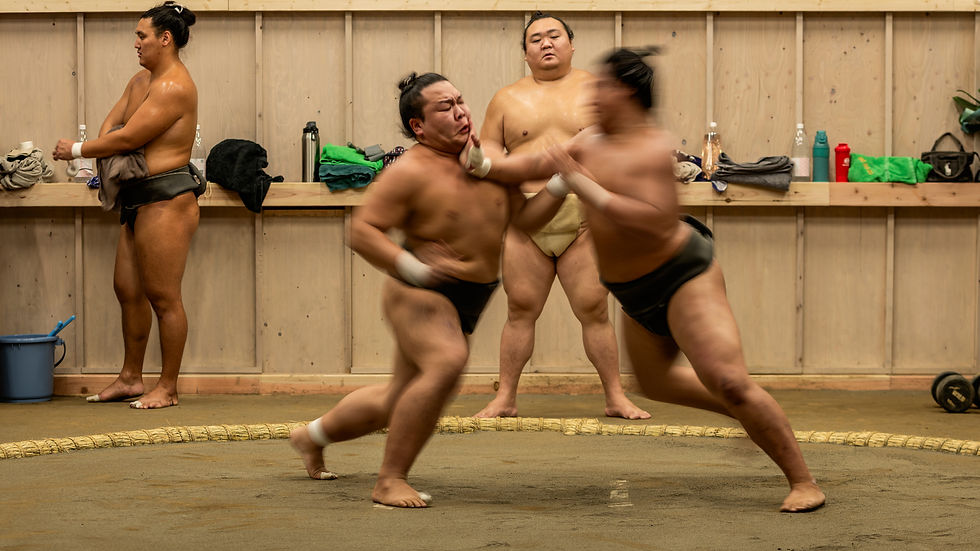Beyond the Ring: A Private Sumo Practice in Tokyo
- Jordan

- Oct 31
- 4 min read
Typically, when I walk through the streets of Tokyo on a weekday morning, I see countless men and women in business attire. However, on this crisp autumn morning, I was in a very different part of the city.
Instead of an endless flowing river of suits and ties, I saw larger men in traditional Japanese clothes and perfectly styled hair.
A Different Side of Tokyo
While many know Tokyo as a bustling city full of neon lights and corporate headquarters, Ryogoku is the sumo wrestling capital of Japan and home to many of the nation’s top sumo stables, or ‘beya.’ I don’t often find myself in this rustic part of Tokyo, but as luck would have it, I was granted the opportunity to sit in on a private sumo morning practice at a Tokyo sumo stable.

Inside a Tokyo Sumo Stable: Experiencing a Private Morning Practice
As I stepped into the sumo stable, I could already hear the faint sounds of the morning ritual.
Upon entering the training room, I was greeted by a group of wrestlers already in the midst of their daily routine. As they do each morning, the wrestlers had started their day by doing what is known as ‘shiko,’ a traditional form of exercise used to build strength and improve balance. As I took my seat in the viewing area, I allowed myself to take in the atmosphere.
Depictions of sumo stables on TV and in movies had led me to expect a rundown, dimly lit space, but to my surprise, it was much more modern than I had expected.
The training area was incredibly clean, spacious, and well-lit by the natural light shining through its many windows. I made myself comfortable and continued to watch as the wrestlers finished their morning warm-up routine.

The Morning Sparring: Strength and Hierarchy in Action
Next on the agenda was what I considered to be the main event for the morning, an up close and personal viewing of their daily sparring. As is tradition, the younger of the sumo wrestlers kicked things off.
While many people may be more accustomed to the higher-ranking fights televised during the sumo tournaments, there is something special about watching the newer wrestlers in action. While their technique is not quite as refined, their passion cannot be questioned.
Between each fight, they would seek feedback from their leader, the Oyakata, a retired Yokozuna whose words were few but whose messages were clear. Though much in the sumo world has become modernized, the hierarchy is a tradition that holds strong to this day.

Stories Within the Stable
Throughout the practice, I tried to take in the individual moments within the grander scene. While the sparring was incredible, it was the stories around the stable that caught my eye. Some wrestlers took the opportunity to mirror the techniques they saw, others lifted weights, and a few younger wrestlers paired off with their seniors for advice.
Between each bout, the reaction of the losing wrestler varied. While some showed visual frustration, I noticed one younger wrestler who would always look up at the sumo wrestler rankings posted on the wall.
To my surprise, I didn’t see a look of dejection, but rather one of determination. The rankings hung over his head every morning, serving as a constant reminder of where he was and the goal he and others dream of achieving, the rank of Yokozuna.

Up Close with the Wrestlers
Unlike a typical public viewing, my morning didn't end after the training was finished. As I had the stable all to myself, some of the sumo wrestlers made their way to where I was seated and had the chance to speak with them.
I was no stranger to sumo wrestling, as my mother was a big fan when I was growing up, but I’d be lying if I said I wasn’t a little lost for words. My whole life, I’d seen sumo wrestlers as these larger-than-life athletes on TV, but as soon as practice was over, they transformed into normal guys, well, as normal as someone who can crush you with one finger can be, but that’s besides the point.
We discussed their life outside the sumo stable and their path to becoming a sumo wrestler. Contrary to what I thought, not all of them had dreamed of being wrestlers from a young age. One in particular shared how he had played American Football until recently transitioning into sumo wrestling. With the conversation winding down, it was time to move on to lunch.
A Meal Fit for a Sumo Wrestler
I made my way over to the dining area just as a parade of food began to make its way out of the kitchen. Before long, I was sitting in front of an unimaginable amount of food, savory dishes. I had just finished chatting with sumo wrestlers, and now it was time to eat like one. Even after I filled my plates and bowls with scrambled eggs, roast beef, hot pot, salad, and rice, I had barely made a dent in the offerings before me.
The wrestlers kindly offered me seconds, but after just one plate, it was time for me to retire from the sumo lifestyle. I thanked the wrestlers for their time, as I knew they would be traveling for a sumo tournament in the coming days.

How to Experience a Private Sumo Practice in Tokyo
Since my first visit, I have had the opportunity to sit in on several practices at different stables, and I always enjoy watching the stories that each one tells.
Witnessing a private sumo practice in Tokyo is one of our Untold Exclusive Experiences—rare encounters designed to offer deeper access into Japan’s cultural heart.
Just like our private geisha experience in Kyoto, this sumo practice offers an insider’s perspective that few visitors ever see.
If you would like to watch a private sumo morning practice firsthand during your tour, contact us for a free consultation. Who knows, you may even see a future Yokozuna in action.










Comments